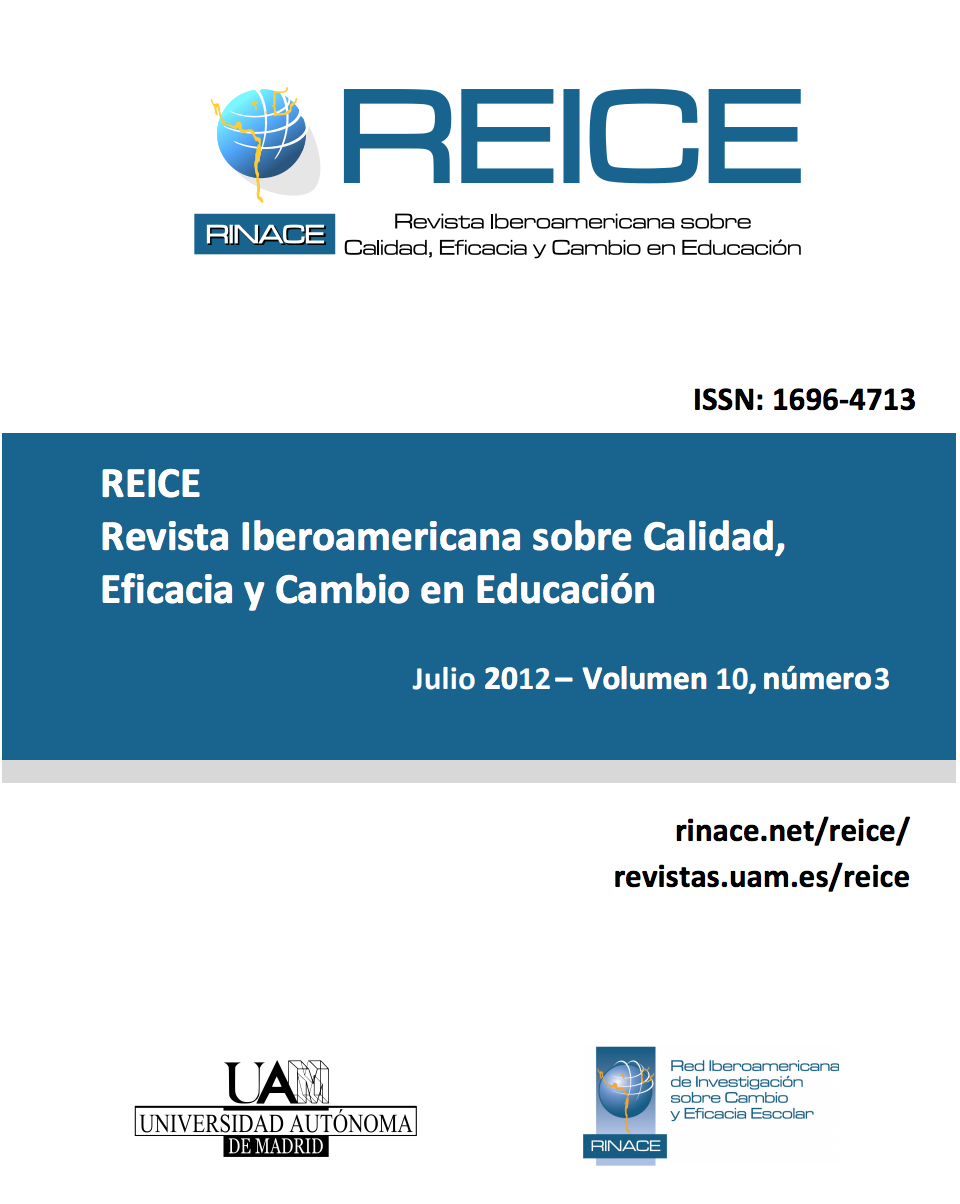Burnout Syndrome and Depressive Symptomatology in Teachers: Relationship Between Type of Teaching and Gender in Public Educational Establishments of Santiago-Chile
Keywords:
Quality, Effectiveness, Change, Improvement, Equity, InnovationCopyright (c) 2016 REICE. Revista Iberoamericana sobre Calidad, Eficacia y Cambio en Educación

This work is licensed under a Creative Commons Attribution-NonCommercial-NoDerivatives 4.0 International License.
Abstract
The characteristics of the Burnout syndrome, make it in a disorder that apart of affecting the life quality, the job and educational performance, could be also associated to the development of other psychological pathologies such as anxiety, addictions and depressive symptoms at different magnitudes. Recent researches have reported that public educational establishments are considered as a focus of high vulnerability by professionals who work in education, mainly for the working conditions that they have to face everyday, in a place of growing demands for a better educational quality. Objective: To describe the presence of SB and depressive symptomatology (SPD) in teachers who work in public schools located in Santiago, and at the same time to link both psychological categories through an analysis of correlation. Subjects: 60 teachers participated, (30 women and 30 men) to which it was applied the Maslach Burnout Inventory (MBI) and the Beck Depression Inventory (BDI). Results: The results show a high coefficient of correlation (R=0.85) between both variables. However, it was impossible to find significant differences between the type of teaching (primary or secondary) and the presence of SDP and SB. Discussion: It is suggested to analyze the characteristics of organizational context of schools, to study the coping styles, self efficacy, self esteem, social support, etc.
Downloads
References
Aldrete, M., Preciado, M., Fanco, S., Perez, J., Aranda, C, (2008). Factores psicosociales laborales y Síndrome de Burnout, diferencias entre hombres y mujeres docentes de secundaria, zona metropolitana de Guadalajara, México. Revista Ciencia y Trabajo, 10(30), pp. 138-142.
Becks, A., Rush, A; Shaw, B., Emery, G. (2005). Terapia Cognitiva de la Depresión. Bilbao: Desclée De Brouwer.
Briones, D. (2007). Presencia de síndrome de burnout en poblaciones policiales vulnerables de Carabineros de Chile. Revista Ciencia y Trabajo, 9(24), pp. 43-50.
Buzzetti, M. (2005). Validación del Maslach Burnout Inventory (MBI), en dirigentes del colegio de profesores de Chile A.G.Memoria para optar al título de psicólogo. Universidad de Chile, Facultad de ciencias sociales, Carrera de Psicología.
Colegio de Profesores de Chile A.G (2000). Informe de estudio de salud laboral de los profesores en Chile. Directorio Nacional, Departamento de Bienestar. www.colegiodeprofesores.cl
Colegio de Profesores de Chile A.G (2007). Profesores quemados, Burnout, la pandemia docente. Directorio Nacional, Departamento de Bienestar. www.colegiodeprofesores.cl
Cornejo, R. (2008). Entre el sufrimiento individual y los sentidos colectivos: Salud laboral docente y condiciones de trabajo. Revista Docencia XVI(35), pp. 77-85.
Del Valle, J., Lopez, M. y Bravo, A. (2007). Job stress and burnout in residential child care workers in Spain. Psicothema 19(4), pp 610-615.
Darrigrande, J.L., Olivares, V., Aguilar, J., Marileo, C., Mansilla, N. y Mendez, J. (2009). El Síndrome de Quemarse por el trabajo (SQT) en profesores de colegios privados y liceos técnicos de Santiago de Chile. Revista de Psicología da IMED, 1(2), pp. 243-252.
Darrigrande, J.L. (2010). Vulnerabilidad y exclusión social en Chile: aportes desde la psicología de la salud. Revista Praxis, 11(16), pp. 47-54.
Darrigrande, J.L. (2011). Psicología y salud pública: Determinismo estructural v/s estilos de vida saludables. Ponencia presentada en Congreso de Psicología y cambio social, Universidad de Las Américas, Concepción-Chile, noviembre 2011.
Ferrel, F., Rubio, B. y Pedraza, C. (2009). Síndrome del Quemado (Burnout) en Docentes Universitarios, de una Universidad Pública del Magdalena, Colombia. Ponencia presentada en VI Congreso Iberoamericano de Psicología Clínica y de la Salud. Santiago de Chile, Octubre 2009.
Freudenberg, H.J. (1974). Staff Burnout. Journal of Social Issues, 30(1), pp. 159−165.
Gil-Monte, P. (2002). Validez factorial de la adaptación al español del Maslach Burnout Inventory-General Survey. Revista Salud Pública de México 44(1), enero-febrero de 2002, México pp. 33-40.
Gil-Monte, P., García-Juesas, J. y Caro, M. (2008). Influencia de la sobrecarga laboral y la autoeficacia sobre el síndrome de quemarse por el trabajo (burnout) en profesionales de la enfermería. Revista interamericana de Psicología, 42(1), pp. 113-118.
Gómez, C., Figueroa, D., Figueroaa, M. e Yfran, E. (2007). Depresión en docentes de Escuela Primaria de la ciudad de corrientes. Revista de Posgrado de la VI Cátedra de Medicina, 173, pp. 1-3. Disponible en: http://kinesio.med.unne.edu.ar/revista/revista173/1_173.pdf
Karasek, R., y Theorel, T. (1990). Healthy work, stress, productivity and the reconstruction of working life. New York: Basic Books.
Marrau, C (2004). El Síndrome de Burnout y sus posibles consecuencias en el trabajador docente. Fundamentos en Humanidades.
Maslach, C., Jackson, S.E. y Leiter, M.P. (1996). Maslach Burnout Inventory manual . California: Consulting Psychologists Press.
Lazarus R.S. y Folkman, S. (1984). Coping y adaptation. En: Gentry WD (eds) The Handbook of behavioral medicine: New York: Guilford.
Pines, A. (1993). Burnout: An existential perspective. In W. B. Schaufeli, D. Maslach, y T. Marek (Eds.), Professional burnout: Research developments in theory and research. Washington, D.C.: Taylor y Francis.
Redondo, J. (2009). La educación chilena en una encrucijada histórica. Revista Diversia 1(1); pp. 13-39.
Rodriguez, J., y Zurriaga, R. (1997). Estrés, enfermedad y hospitalización. Granada: Escuela Andaluza de Salud Pública, 1997.
Shea, P. (2006). A study of students' sense of leaning community in online environments. Journal of Asynchronous Learning Networks, 10(1). Disponible en: http://www.sloan-c.org/publications/jaln/v10n1/v10n1_4shea.asp.
Valdivia, G., Avendaño, C., Bastías, C., Milicic, N., Morales, A. y Scharager, J. (2000). Estudio de la salud laboral de los profesores en Chile. Pontificia Universidad Católica de Chile, Escuelas de psicología y medicina. Facultad de Ciencias sociales y Medicina.
Velasco, A., y Huneeus, C. (2011). Contra la desigualdad, el empleo es la clave. 1ª edición, Santiago de Chile: editorial Debate.
